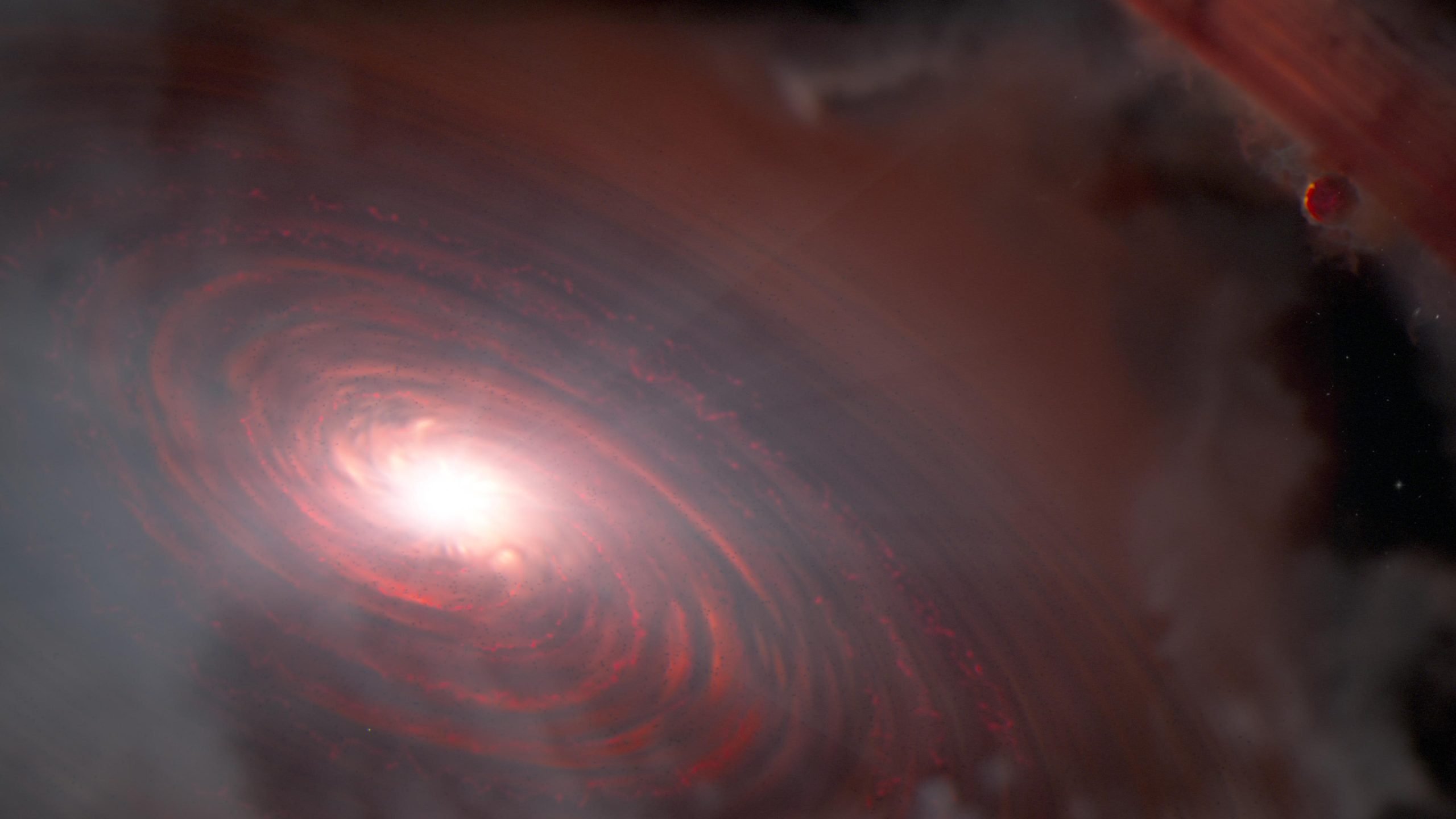
This artist’s concept depicts the star PDS 70 and its inner protoplanetary disks. New measurements from NASA’s James Webb Space Telescope have found water vapor less than 100 million miles from the star — the region where rocky, terrestrial planets form. This is the first detection of water in the terrestrial region of a disk already known to host two or more protoplanets, one of which is shown at top right. Credit: NASA, ESA, CSA, Joseph Olmsted (STScI)
The discovery shows that terrestrial planets have water reservoirs.
Water, water, everywhere – not in drops, but as steam. Scientists use NASAs The James Webb Space Telescope They discovered that thirsty planets in the PDS 70 system have access to a reservoir. Importantly, the vapor was found within 100 million miles of the star – the region where terrestrial planets like Earth could form. (Earth orbits 93 million miles from our Sun.)
PDS 70 is cooler than our Sun and is estimated to be 5.4 million years old. It is home to two known gas giant planets, at least one of which is still accreting material and growing. This is the first detection of water in the terrestrial region of a disk already known to host two or more protoplanets.

A spectrum of the protoplanetary disk of PDS 70, obtained with the Webbs MIRI (Mid Infrared Instrument), shows several emission lines from water vapor. Less than 100 million miles from the star — the region where rocky, terrestrial planets form — the system’s inner disk contains water, the scientists determined. Credit: NASA, ESA, CSA, Joseph Olmsted (STScI)
The Webb Space Telescope detects water vapor in the Rocky Planet-Forming Zone
We all know that water is essential for life. However, how water reached Earth and whether the same processes could seed rocky exoplanets orbiting distant stars remain topics of scientific debate. These discussions may yield new insights from the planetary system PDS 70, located 370 light-years away. This star system consists of both an inner and outer disk of gas and dust separated by a distance of 5 billion miles (or 8 billion kilometers). Two known gas-giant planets reside in this interval.
New data collected by NASA’s James Webb Space Telescope’s MIRI (Mid-Infrared Instrument) has found vapor in the system’s inner disk less than 100 million miles (160 million kilometers) from the star — a region where rocky, terrestrial planets can form. (Earth orbits 93 million miles from our Sun.) Remarkably, this is the first time that water has been detected on the surface of a disk already confirmed to host two or more protoplanets.
« We’ve seen water in other disks, but not so close in the system where the planets are currently assembled. We couldn’t make this kind of measurement before Webb, » said lead author Giulia Perotti of the Max Planck Institute for Astronomy (MPIA) in Heidelberg, Germany.
« This discovery is particularly exciting because it probes the region where rocky Earth-like planets typically form, » said MPIA Director Thomas Henning, a co-author on the paper. Henning is co-principal investigator of Webb’s MIRI (Mid-Infrared Instrument).
A vapor environment for the formation of planets
PDS 70 is a K-type star, cooler than our Sun, with an estimated age of 5.4 million years. It is relatively old in terms of stars with planet-forming disks, which made the discovery of water vapor surprising.
Over time, the gas and dust content of the planet-forming disks decreases. Either the radiation and wind from the central star ejects such material, or the dust grows into larger objects and eventually forms planets. Since previous studies had failed to detect water in the cores of similarly aged disks, astronomers suspected that they could not sustain intense stellar radiation, leading to a dry environment for the formation of any rocky planets.
Astronomers have yet to detect any planets forming within PDS 70’s inner disk. However, they find the raw materials for building rocky worlds in the form of silicates. The detection of water vapor suggests that if rocky planets formed there, they would have had access to water early on.
« We see a relatively large number of small dust grains. Together with the detection of steam, the inner disk is the most exciting place, » said co-author Rens Waters of Radboud University in the Netherlands.
What is the origin of water?
This discovery raises the question of where the water came from. The MINDS team considered two different scenarios to explain their finding.
One possibility is that water molecules form in place as hydrogen and oxygen atoms combine. A second possibility is that ice-covered dust particles are transported from the cold outer disk to the hot inner disk, where the water ice sublimates and turns into water vapor. Such a transit system would be surprising given that the dust would have to cross the large gap carved by the two giant planets.
Another question raised by the discovery is how water can survive so close to the star when the star’s ultraviolet light breaks up any water molecules. Often, surrounding materials such as dust and other water molecules act as a protective shield. As a result, the internal disk of the PDS 70 will withstand the water damage detected.
Ultimately, the team will use Webb’s two instruments, NIRCam (near infrared camera) and NIRSpec (near infrared spectrometer), to study the PDS 70 system in an effort to gain an even greater understanding.
These observations were taken as part of the Guaranteed Time Observation Project 1282. The findings are published in the journal Nature.
Note: G. Perotti, V. Christians, The. Henning, B. Tabone, LPFM Waters, I. Camp, G. Olofson, SL Grant, D. Gassman, J. Bowman, M. Samland, R. Franceschi, EF van Dishoek, K. Schwarz, M. Goodell, P.-O. Luggage, DP Ray, P vandenbussche, Abergel A, Absil O, Arabavi AM, Argrio I, Barrado T, Boccaletti A, Garati O Garati A, Geers V, Glaser AM, Justondt K, Lahuis F, Müller M, Nehme C, Szeeta Gudang E, Szelda Gudang E, J. Kanwar, M. Morales-Calderon, N. Pavelec, D. Rodgers-Lee, J. Schreiber, L. Colina, TR Grave, G. Astlin and G. Wright, 24 July 2023, Nature.
DOI: 10.1038/s41586-023-06317-9
The James Webb Space Telescope is the world’s premier space science laboratory. Webb solves the mysteries of our solar system, looks beyond to distant worlds around other stars, and explores the mysterious structures and origins of our universe and our place in it. WEB is an international project led by NASA’s partners, ESA.European Space Agency) and the Canadian Space Agency.






